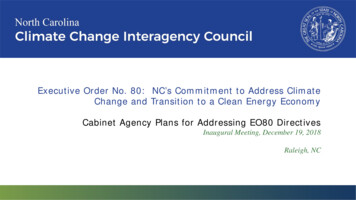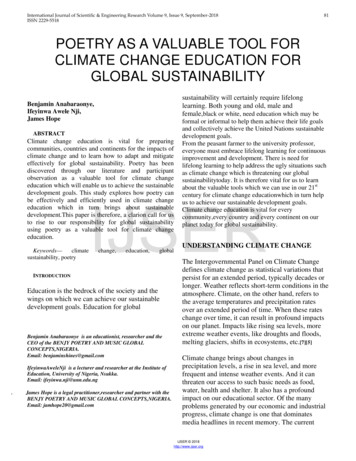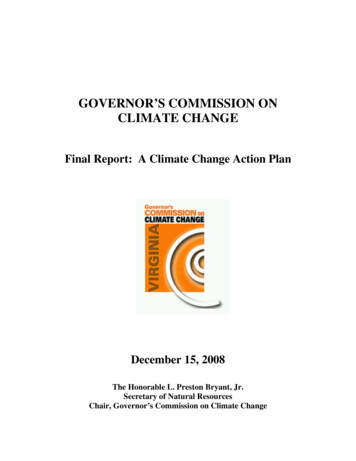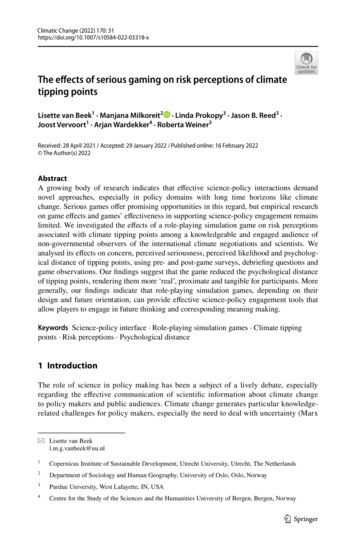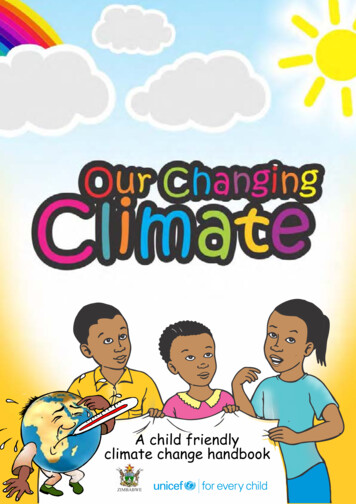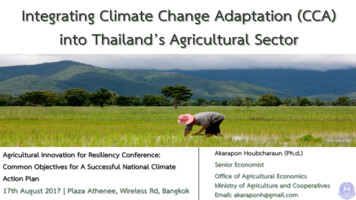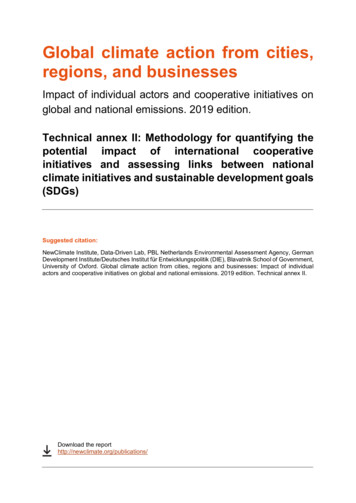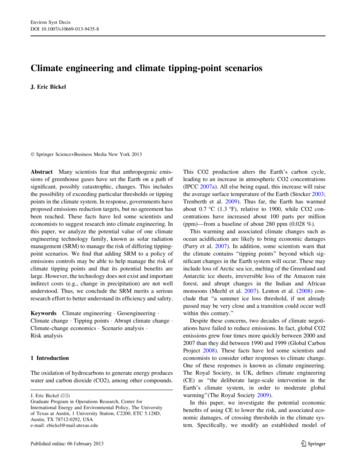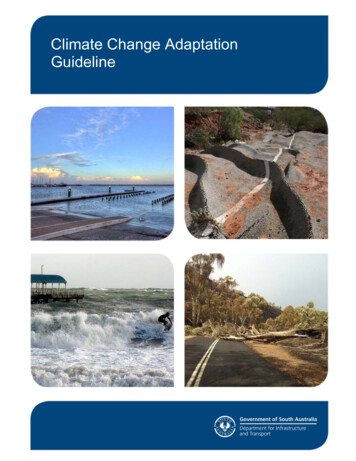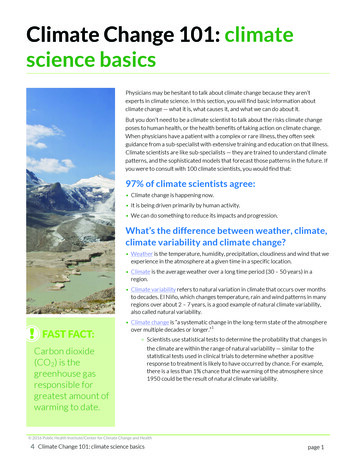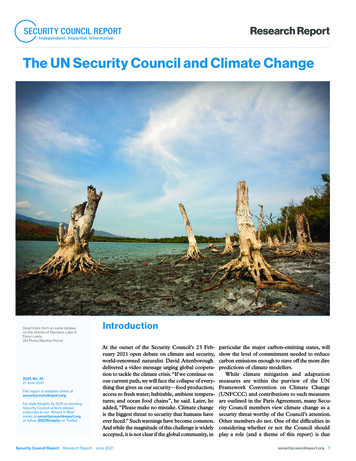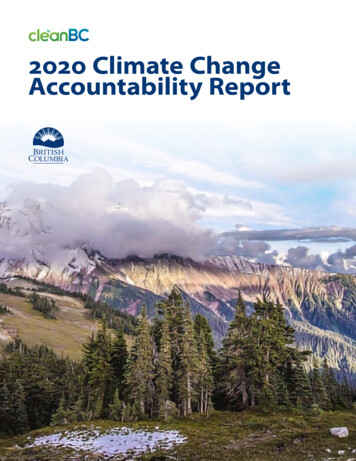
Transcription
2020 Climate ChangeAccountability Report
22020 Climate Change Accountability ReportTABLE OF CONTENTSMessage from the Minister41.Executive summary62.Progress to our targets102018 emissions performance – most recent dataProvincial Greenhouse Gas Emissions InventoryEconomic transition (GHG emissions per GDP and per capita)101112Near-term outlook13CleanBC projections14Sector-specific emissions summaryTransportationIndustryBuildings and communities16171819Carbon tax revenue and climate-related spending19Getting results with CleanBC21Cleaner transportation22Improve where we live and work25Reduce waste29Cleaner industry30Helping people get the skills they need343.
32020 Climate Change Accountability Report4.Preparing for a changing climate35Climate risks in B.C.35Preparing for climate risks36Public sector organizations preparing for future impacts37Working together39Inter-governmental collaborationIndigenous PeoplesLocal governmentFederal government39394040Climate Solutions Council40Engaging with British Columbians and other partners41Public sector climate leadership4210th Anniversary of Carbon Neutral Government (CNG)42Emissions performance – 2019 reporting year42Benefits of public sector leadership43Appendix 1: CleanBC Initiatives by sector455.6.
42020 Climate Change Accountability ReportMESSAGE FROM THE MINISTERWe’re working hard to fight climate change and build a stronger, cleanerfuture for all of us.When we launched CleanBC at the end of 2018, we knew the challenges andopportunities ahead. Greenhouse gas emissions in British Columbia had beensteadily rising and significant new policies and programs were needed to getus back on the path to meeting our targets and building a cleaner economyfor everyone.People in British Columbia care deeply about the environment and makingsure we all do our part to build a cleaner, better future for our kids andgrandkids. It’s something I have heard consistently across all parts of ourprovince, from different groups of people, in communities big and small.We are seeing the effects of climate change in our daily lives, from increased wildfires and smoke,to more frequent floods and droughts. Our call to action is clear -- we need to keep driving downclimate pollution.And that’s exactly what we set out to do with CleanBC. Legislated new targets and dozens of newpolicies and programs across all sectors of the economy are now underway, many of which are amongthe strongest in North America. Still more actions will be developed and we will see more results in themonths and years ahead.As part of CleanBC, we also strengthened government’s reporting requirements to the public through anew climate accountability law in 2019. This report is the first produced under the new legal requirementwe set up, and includes a wide range of detailed information to help track our progress as a province.Each year, government is required to report on everything from the latest greenhouse gas emissionsestimates, projections for emissions in future years, expected outcomes of climate actions andexpenditures, and steps taken to manage the risks from climate change.It’s part of our commitment to transparency and accountability. It’s critical that we monitor the stepswe’ve taken each year and adjust as needed, taking into account any new information and data thatbecomes available. We are also listening to the advice of the Climate Solutions Council as we worktowards closing the gap to our target, and I want to sincerely thank them for their hard work anddedication over the past year. The Council’s greatest strength is its ability to reach consensus and provideadvice that represents the diversity of viewpoints in B.C.This year’s climate accountability report shows a change in overall emissions from 2018 – the latestavailable emissions data – due in part to new methodology from the federal government that reset the2007 emissions baseline. While the 2018 reporting period predates the launch of CleanBC, it does affectemission projections for future years. It means, based on our current assumptions and forecasts, thereis more work to do to achieve our targets than previously anticipated and more actions with strongerresults are needed to achieve our goals.When CleanBC was released in December 2018 we committed to releasing measures to close the gap toour 2030 target within two years. We encountered unexpected challenges, and while we have not metthis target date we will redouble our efforts and release a detailed roadmap to the 2030 targets by the
52020 Climate Change Accountability Reportend of next year. Areas for future action that have strong potential to further reduce emissions includetransitioning heavy-duty fleets to cleaner fuels, reducing emissions in heavy and light industry, divertingand using waste more efficiently, and making new and existing buildings more energy efficient.We will also work with the federal government as it releases its plans to meet Canada’s greenhousegas targets to ensure our efforts are coordinated and that we find the most efficient pathways to meetour goals.The COVID-19 pandemic has shown just how quickly and dramatically things can change andunderscores the importance of our government’s economic recovery plan that includes significant newCleanBC commitments. These actions and the pandemic more broadly will have important effects onour economy and emissions outcomes for 2020 and beyond.CleanBC is putting our province on the path to a cleaner, better future. Whether it’s ensuring all newvehicles will be zero emission, making new buildings net-zero energy ready, or supporting communitiesand Indigenous peoples transition to clean technology, we’ve made significant progress creating newopportunities for people and reducing pollution. Together, we’re building a cleaner, more secure future –and that means more jobs and opportunities for everyone in B.C.George HeymanMinister of Environment and Climate Change Strategy
62020 Climate Change Accountability Report1. EXECUTIVE SUMMARYWhen we launched our CleanBC plan in December 2018, we laid out a pathway to reduce emissions andcreate a better future for B.C. While much has been accomplished, there is still more to do.This 2020 Climate Change Accountability Report summarizes B.C.’s actions and progress towards astronger, cleaner future. It is the first to be tabled publicly in the legislature as part of our commitment toimprove climate change accountability.We are committed to achieving our targets while making life better, cleaner, and more affordable forBritish Columbians. While it is too early to determine the sustained impact of CleanBC initiatives onprovincial greenhouse gas emissions, it is clear that reaching our targets will require renewed focus andfurther government action.Together with a range of partners, we’ve made good progress implementing the plan and laying thefoundation for a cleaner, stronger, low-carbon economy. By rising to the challenge of climate change,we’re protecting our communities, expanding B.C.’s economy, and creating opportunities and jobs forpeople across our province.Moving ahead during the 2019-2020 fiscal yearOver the last two years, we’ve worked with many organizations, governments and communities toput our CleanBC plan into action. And this year, working with Indigenous leaders, we’ve also laidthe foundation for renewed action to address climate risks under a new climate preparedness andadaptation strategy.So far, we’ve seen several early signs of success. We’ve had a dramatic increase in the sale of new electriclight duty vehicles – B.C.’s zero-emissions vehicle sector contributed more than 600 million to theprovincial economy. We’ve seen more household heat pump sales thanks to increased CleanBC rebatesto boost their uptake. We’re working with industry to adopt cleaner operations and reduce emissionsthrough the CleanBC Program for Industry. And we’ve launched a Plastics Action Plan to reduce singleuse plastics and consumer waste.As programs change and develop over time, we will continue to report on our CleanBC activities to makesure we are accountable on our progress to our targets.Responding to the COVID-19 PandemicWhile this report focuses primarily on actions throughout the 2019-2020 fiscal year, it’s important torecognize the impact of the COVID-19 pandemic on government initiatives throughout the remainderof 2020. Our pathway to a cleaner future is even more important as we work to come out of COVID-19stronger and better prepared.The Province recently released StrongerBC, B.C.’s Economic Recovery Plan to help people, businessesand communities recover. It builds on the progress we’ve made under CleanBC with over 220 millionin additional new investments. This will help reduce emissions in transportation, support low-carboninnovation, restore critical watersheds and protect habitat, create jobs, and tackle climate change whilepreparing for its impacts. This is in addition to the 1.3 billion committed to CleanBC over four years tohelp people and businesses use clean energy to get around, heat our homes, and fuel industry.
72020 Climate Change Accountability ReportOur current emissions outlookWhile we’ve made progress in reducing the carbon intensity of our economy, which is down 16% since2007, B.C.’s strong economy and growing population have placed upward pressure on overall emissionsand have contributed to recent increases at the provincial level.In 2018, our gross greenhouse gas (GHG) emissions were 67.9 million tonnes of carbon dioxide equivalent(Mt CO2e). This represents an increase of 4.5 Mt CO2e from 2007 levels, 3% higher than 2017 emissions.These 2018 numbers, which are the most recent available, certainly reinforce the importance oflaunching CleanBC and taking strong action to address climate change. CleanBC was launched at theend of 2018, meaning these results do not capture the impact of CleanBC actions, or take into accountfurther actions planned as part of rebuilding from the COVID-19 pandemic.Our models show that in 2019, B.C.’s emissions are expected to stabilize or slightly increase, beforebeginning to decrease in 2020 as CleanBC programs begin to take hold and we see the effects ofCOVID-19. Emissions may level-off in 2021 as B.C.’s economy begins to recover and then continue adownward trajectory in 2022 as more CleanBC policies start to take effect.Working together for a cleaner, stronger futureCollaboration on CleanBC remains a priority, and government is continuing to engage with industryand business, Indigenous leaders and communities, governments and other organizations, and BritishColumbians.Members of the Climate Solutions Council have provided valuable input to help strengthen CleanBC asit has developed over time. The Council’s contributions have helped ensure we’re focused on policy thatimproves peoples’ lives while reducing emissions and supporting a clean economy.Through a series of engagements with Indigenous peoples, we have heard that climate change is havingserious impacts on their communities, cultures, health and livelihoods, and they are keenly interestedin being involved in solutions. We’ve been working closely with the First Nations Leadership Counciland the Indigenous Climate Adaptation Technical Working Group, and sought input from Indigenousgovernments, organizations and communities to develop a climate preparedness and adaptationstrategy that will help us prepare for the impacts of climate change. We’re also working together todevelop clean energy infrastructure in remote communities, increase economic opportunities, andprovide better access through such programs as an Indigenous Community Heat Pump incentive andthe Indigenous Community Energy Coach Program.Together with industry, we are working on strategies to strengthen B.C. as a destination for newinvestment to meet the growing global demand for low-carbon solutions. Most B.C. industry is, onaverage, less carbon-intensive than our competitors, in part due to B.C.’s carbon tax, which hasencouraged cleaner industrial operations since 2008 when it was put in place. The ideas, initiativesand technologies that reduce our emissions and prepare us for the future can also create economicopportunities. The fiscal year 2019-2020 represents an early yet important period in establishing andbuilding momentum for our plan. And there is more work to do. We are working closely with partnersand building new partnerships with youth, local communities and many more organizations to helpmeet our CleanBC goals. It will take further collaboration to deliver on the next slate of CleanBC policiesto continue bending our emissions pathway toward our 2030 target and creating a cleaner future.
82020 Climate Change Accountability ReportCleanBC milestones achieved¡ Improved uptake of GoElectric rebates andBetter Homes & Better Buildings rebates forcleaner vehicles and buildings.¡ Introduced new financing programsto support purchase of heat pumps forhousehold heating.¡ Increased personal climate action tax credits,tied to carbon tax revenues.THE CLIMATE CHANGEACCOUNTABILITY ACTTo help keep CleanBC on track, the Provinceestablished a framework for strongeraccountability under the Climate ChangeAccountability Act.The Act requires the Province to annually:¡ publish its most recent GHG inventory;¡ Completed a first of its kind climate riskassessment for B.C. and committed toreducing risks from wildfire, flooding, anddroughts through the development of acomprehensive climate preparedness andadaptation strategy.¡ estimate B.C.’s emissions for the currentyear and next three years;¡ Through new legislation, mandatedescalating sales targets for zero emissionlight duty vehicles in the province andincreased incentives for specialty-use,medium- and heavy-duty vehicles.¡ report on actions taken and proposedto reduce emissions and manage risksfrom climate change;¡ Launched B.C.’s first active transportationstrategy, including cost-shared fundingfor cycling and walking infrastructure andnetwork planning.¡ Released world-leading industry emissionsbenchmarks under the CleanBC IndustrialIncentive Program, encouraging cleanerindustrial operations by returning a portionof the carbon tax to low emission facilities toincentivize further emissions reductions.¡ outline expected outcomes of climateaction;¡ report on expenditures to reduceemissions and manage risks;¡ report on reducing emissions andmanaging risks across the provincialpublic sector; and¡ outline advice received from theindependent Climate Solutions Council.Details to fulfill these commitments areincluded in this report.The Act also requires the government to setan interim GHG target by December 31, 2020,and sectoral targets by March 31, 2021.
92020 Climate Change Accountability ReportPrograms now underway¡ Launched the CleanBC Industry Fund, closing a second call for innovative emissions reductionprojects in June 2020.¡ Started new clean energy, electric vehicle (EV) charging, housing and other infrastructure projectsunder the new CleanBC Communities Fund and expanded the BC Indigenous Clean EnergyInitiative and other rural clean energy funds.¡ Increased the carbon intensity requirement of B.C.’s Low Carbon Fuel Standard to a 20% reductionin average carbon intensity by 2030 from 2010 levels.¡ Finalizing the BC Hydro review to ensure affordable electricity supply and support neweconomic opportunities.¡ Expanded composting capacity to turn waste into clean products, for example with biogas andsolid composting.¡ Launched the CleanBC Plastics Action Plan, which enabled local government to put in placemunicipal bans and committed to begin the phase-out of single-use plastics province-wide.¡ Created innovation funding to develop net-zero energy ready buildings, expanded a promisingEV sector (including through the Specialty-Use Vehicle Incentive Program), and built on innovativeclean energy technologies.¡ Began developing new initiatives including the BC bioenergy strategy and hydrogen strategy.¡ In 2020, we announced funding for a new centre for Innovation and Clean Growth underStrongerBC, the Province’s economic recovery plan.
102020 Climate Change Accountability Report2. PROGRESS TO OUR TARGETSBritish Columbia has set ambitious greenhouse gas (GHG) reduction targets. We’re working towardsemission reductions from 2007 levels of 40% by 2030, 60% by 2040, and 80% by 2050.In December 2018, we launched CleanBC, our climate, clean energy and economic plan. It lays out aseries of actions over the next decade to reduce emissions across all sectors of our economy. Whenreleased, our plan was estimated to get us three-quarters of the way to our 2030 goal and included acommitment to release details on closing the gap by December 2020.That commitment remains outstanding, but we will release a detailed roadmap to meet our 2030 targetsby the end of next year. We are looking at areas where existing programs can be adjusted or enhanced,and new actions are being developed in areas such as transitioning heavy-duty fleets to cleaner fuels,reducing emissions in heavy and light industry, diverting and using waste more efficiently and makingnew and existing buildings more energy efficient.The Province will also continue to assess the effectiveness of our current CleanBC actions over time andwill further engage with Indigenous peoples, industry and other partners.We will also work with the federal government on initiatives from Canada’s climate plan that build on ourprovincial action and increase the impact of CleanBC.This section provides an update on our progress, including information in five areas:a) 2018 emissions performance - most recent datab) Near-term outlookc) CleanBC projectionsd) Sector-specific emissions summarye) Carbon tax revenue and climate-related spendingBritish Columbians can learn more about what we’ve accomplished over 2019-2020 in this report, andaccess even more detail online through the Mitigation table and the Managing Climate Risk table.2018 emissions performance – most recent dataThe Province measures GHG emission performance in three ways – gross and net emissions, emissionsper capita, and emissions per Gross Domestic Product (GDP) – also known as the ‘carbon intensity’ ofthe economy. Overall, the carbon intensity of B.C.’s economy has decreased 16% since 2007 and GHGemissions per capita have gone down 8% since 2007.While these are encouraging trends, continued economic and population growth have translated to anincrease in overall emissions. Our province-wide net emissions (across all sectors) have increased in 2018by 3.5 million tonnes carbon dioxide equivalent (Mt CO2e) from 2007 levels.The following sections explains these indicators in further detail.
112020 Climate Change Accountability ReportNet GHG emissionshave increased in by . Mt CO efrom levelsThe carbon intensityof our economy hasgone down since GHG emissions percapita are down since Provincial Greenhouse Gas Emissions InventoryThis report provides data from the 2018 emissions reporting year - the most recent information availabledue to a 16-24 month lag for data collection by the federal government and reviewed by the B.C.government before the reporting date.1 B.C.’s annual emissions reporting is based on the most recentnational inventory from Environment and Climate Change Canada, and it takes time to collect and verifythe data from a wide range of sources.It is also important to note that the 2018 emissions data does not yet include the impact of new actionsfrom CleanBC, which began implementation in 2019 and continues to roll out.In 2018, B.C.’s gross GHG emissions were 67.9 million tonnes of carbon dioxide equivalent (Mt CO2e). Thisrepresents an increase of 4.5 Mt CO2e (7%) from 2007 levels, and 2.2 Mt CO2e (3%) from 2017 emissions.Once we include 1.0 Mt CO2e in emission reductions from offset projects, our net2 GHG emissions were66.9 Mt CO2e. This represents a net increase of 3.5 Mt (6%) from 2007 levels, our target baseline year.The increase in emissions in 2018 was largely due to increases in fuel consumed in heavy-duty dieselvehicles, oil and gas extraction, off-road industrial transport, and light-duty gasoline-powered trucks.Our measurements of the increase in emissions from 2007 and from 2017 were also impacted bytechnical changes in reporting methodology for the 2018 emissions inventory that affect past years’totals. These include:¡ The federal government changed how marine transport emissions are calculated. Using the newmethod, B.C.’s 2007 baseline is now 1.5 Mt CO2e lower than it had been reported in the previousemissions inventory. While B.C.’s 2030 target of 40% below 2007 levels remains the same, thechange to 2007 baseline emissions levels means that additional emission reductions will berequired to reach the same target level.¡ In addition, total B.C. gross emissions in 2017 were revised upwards by 1.3 Mt CO2e, due to newestimates for fuel use in several sectors.The overall increase in the 2018 emissions reinforces the importance of taking strong action to addressclimate change through CleanBC.1More detail on the 1990-2018 emissions inventory is available on B.C.’s Provincial Inventory website.2Net emissions are gross GHG emissions (as reported in the B.C. Provincial Inventory) less the offsets from B.C. forestmanagement projects that have been validated under B.C. government regulated offset standards.
122020 Climate Change Accountability ReportEconomic transition (GHG emissions per GDP and per capita)Another way to consider our emissions is in the context of a growing population and economy.Indicators in this area measure how well B.C. is doing in reducing our emissions intensity, as we make thetransition to a cleaner economy with fewer GHG emissions.Between 2007 and 2018, net GHG emissions grew by 6% while the economy grew by 26%. That meansthat the GHG intensity of our economy decreased by 16% since 2007.3 , 500280,000260,000 450240,000 , 220,000400200,000350180,000 160,000300 140,000 , 250120,000200100,000 Tonnes of CO e per million dollars of GDPMillion dollars of GDP ( CDN)Carbon Intensity of the EconomyGHG emissions per person have also fallen. Between 2007 and 2018, they decreased roughly 8%from 14.2 tonnes of CO2e to 13.1 tonnes.4 This places B.C.’s emissions per capita well below theCanadian average of 20 tonnes per capita, but higher than a number of other jurisdictions (e.g. Ontario,Netherlands and Germany at 12, 11 and 10 tonnes per capita, respectively).5.516.0 . 15.5 . 15.014.513.513.012.512.04.5 . . 14.05.0 . . 4.03.53.0Population of British Columbia (millions)Tonnes of CO e per personCarbon Emissions and Population GrowthWhile we’ve made progress since 2007 in reducing the intensity of emissions – for example in theemissions per person or per unit produced in our economy – B.C.’s growing economy and population3Carbon intensity of the economy is measured using net emissions to align with the assessment of B.C.’s progress totargets, whereas GHG emissions per capita uses gross emissions minus afforestation and deforestation to allow forcomparison to other jurisdictions.4Note that CO2e figures exclude land use and land use change emissions to enable comparison with international totals.
132020 Climate Change Accountability Reportare placing upward pressure on emissions and have contributed to recent increases in overallGHG emissions.As CleanBC policies are implemented, we need to continue to de-couple emissions from growth to loweremissions and transition to a low-carbon economy. Finding new ways to prevent waste, use energy moreefficiently, and choose the cleanest possible energy will create more opportunities for building a strong,sustainable economy.Near-term outlookConsistent with our commitments under the Climate Change Accountability Act, we estimate GHGemissions for the four years following the most recently available GHG emissions data. We’ve updatedour modelling as part of a regular series of improvements to include the most recent B.C. emissions dataand real-world trends in areas such as fuel prices, economic data and technological costs.COVID-19 AND GHG EMISSIONSLower emissions from the pandemic are unlikely to be a long-term trend, especially if mitigation efforts are not strengthened.That’s why CleanBC is an important part of B.C.’s Economic Recovery Plan to help people, businesses and communitiescome out of COVID-19 stronger and better prepared. We have an opportunity to rebuild in a way that takes meaningful actionon reconciliation with Indigenous peoples, while reducing emissions and opening opportunities for sustainable jobs and cleaneconomic growth.Our recovery plan builds on the progress we’ve made with over 220 million in new investments in programs that will help creategood new jobs while reducing greenhouse gas emissions, restoring critical watersheds and habitat, and preparing for the impactsof a changing climate. This includes investing more than 130 million to help people and businesses drive down emissions – andmake further progress towards meeting our legislated targets – as well as investing approximately 90 million to help B.C. preparefor and adapt to a changing climate. Government will work closely with industry, business, Indigenous nations and others toimplement this new funding, and identify other opportunities to reduce our carbon intensity.In addition, several other programs in B.C.’s economic recovery plan have climate and clean growth benefits with 219 million innew investments. Additional funding includes the Community Resiliency Investment program to reduce wildfire risk while creatingover 500 jobs in rural communities, the ‘Connecting British Columbia’ program to expand high-speed internet services for ruralcommunities (which can reduce travel emissions through virtual jobs, services and education), the B.C. Air Access Program toreduce non-aviation emissions at small rural airports, additional incentives for specialty use vehicles, and the Property AssessedClean Energy (PACE) program to pilot innovative financing tools for building upgrades.B.C.’s near-term outlook suggests that emissions may stabilize or slightly increase in 2019, beforedecreasing in 2020 due in part to the effects of the COVID-19 pandemic. Emissions may level-off in 2021as B.C.’s economy begins to recover and then continue a downward trajectory in 2022 as more CleanBCpolicies begin to take effect.We provide near-term emission estimates as a range to better represent uncertainties – whether fromassumptions related to economic activity or updates in modelling methodology. Forecasting hasbecome particularly challenging in 2020 due to the unknown impact of the COVID-19 pandemic, whichis still unfolding, and the trajectory that B.C. will take as we recover.
142020 Climate Change Accountability ReportGHG Emissions Forecast from 2019 to 2022Million tonnes CO e(Mt CO e)75706564.465.867.966.5 to 69.56055 63.0 to 66.5 62.5 to 66.5 61.0 to 65.0 CleanBC projectionsWhen CleanBC was released in December 2018, we estimated that it would reduce annual emissions by18.9 Mt CO2e and get us approximately 75% of the way to our 2030 target.For the year 2020, we show CleanBC projections in a range to better reflect the inherent uncertainty inmodelling the future. This will help account for factors which affect our overall emissions such as higheror lower oil prices, varying levels of industrial growth, or different COVID-19 recovery scenarios.After updating our model with the most recent data, we now estimate our actions will result in a 2030emissions total of between 45.2 Mt CO2e and 49.2 Mt CO2e.5 As a result, based on current modelling, weestimate that our existing CleanBC actions will get us between 56% and 72% towards our 2030 target.Though the new estimates mean we are further from our 2030 target, we are committed to closingthe gap and reporting regularly to maintain transparency and accountability. We will release a detailedroadmap to our 2030 target by the end of next year that considers the valuable advice received from theClimate Solutions Council.This change in expected emissions reductions is due in large part to methodology changes and newinformation contained in the 2018 provincial emissions inventory that resulted in a lower 2007 baselineemissions level.Million tonnes CO e(Mt CO e)Pathway to meeting our climate goals570656055504540352008CleanBC Phase reductions (low estimate)CleanBC Phase reductions (high estimate)Phase policies required to reach targetReference CasePast Emissions2010 2012 2014 2016 2018 2020 2022Gap to 2030 Target:7.2-11.2 Mt(Range is Phase 2 policiesplus the difference betweenthe high and low Phase 1reduction estimates)2024202620282030The Province assesses progress towards meeting its 2030 GHG reduction target by modelling CleanBC policiesto estimate their impact on future emissions. Information on the model’s structure and capabilities as well asthe core assumptions and policy design included in the CleanBC modelling analysis is documented in the 2020Methodology Book.
152020 Climate Change Accountability ReportRecent increases to B.C.’s emissions(described earlier in this section) meanwe have additional ground to cover toreach our 2030 target relative to lastyear’s estimate. While the expectedemissions reductions by 2030 fromannounced CleanBC policies remainsimilar, additional measures will now berequired to close the gap to target.These modelling estimates are likely to change as new policiesare announced and further emissions reductions are included.B.C. remains committed to meeting its reduction targetsthrough CleanBC. The 2018 numbers are a clear reminder thatwe need to c
This 2020 Climate Change Accountability Report summarizes B.C.'s actions and progress towards a stronger, cleaner future. It is the first to be tabled publicly in the legislature as part of our commitment to improve climate change accountability. We are committed to achieving our targets while making life better, cleaner, and more affordable for
